
Environmental Factor, May 2009, National Institute of Environmental Health Sciences
Nobel Laureate Oliver Smithies Gives Rodbell Lecture
By Robin Arnette
May 2009
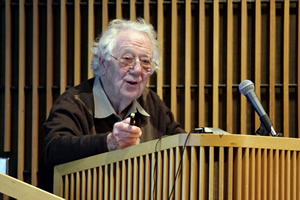
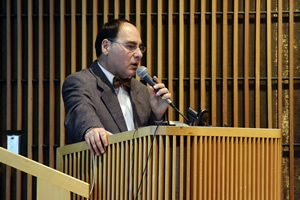
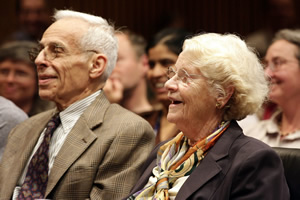
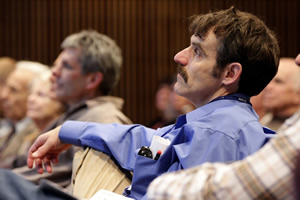
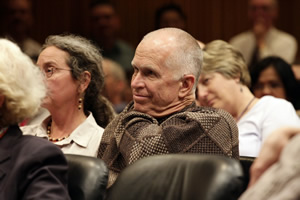
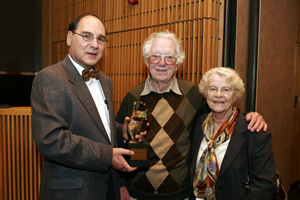
The 2009 Dr. Martin Rodbell (http://www.niehs.nih.gov/about/research/nobel.cfm) Lecture Series speaker, Oliver Smithies, D. Phil., is truly a giant in the field of science. His lecture, "Turning Pages: From Gels to Genes," took place on April 14 and provided an overview of his impressive 61 years of research. Smithies is responsible for developing the gel electrophoresis technique that scientists routinely use today, and he shared the 2007 Nobel Prize in Physiology or Medicine (http://nobelprize.org/nobel_prizes/medicine/laureates/2007/press.html) ![]() for work on the introduction of specific gene modifications in mice using embryonic stem cells.
for work on the introduction of specific gene modifications in mice using embryonic stem cells.
Smithies (http://www.pathology.unc.edu/common/smithies.htm) ![]() thrilled the audience with a presentation that included photocopies of entries from his research notebooks. Pages from his early days showed incredibly detailed writings and hand-drawn lab results. Smithies remarked, "You might wonder why there aren’t any photographs. My lab didn’t have a camera, so everything had to be sketched."
thrilled the audience with a presentation that included photocopies of entries from his research notebooks. Pages from his early days showed incredibly detailed writings and hand-drawn lab results. Smithies remarked, "You might wonder why there aren’t any photographs. My lab didn’t have a camera, so everything had to be sketched."
Smithies credited his undergraduate tutor at Oxford, Alexander "Sandy" Ogston, D.Phil. (http://www.science.org.au/academy/memoirs/ogston.htm) ![]() , with teaching him how to do good science. One of Ogston’s assignments was to have Smithies write an essay on metabolic processes involving energy-rich phosphates. The forward-thinking Smithies generated a diagram that illustrated these phosphates in a continuous cycle. Although Smithies’ scheme was incorrect, he and Ogston found the biochemical error and jointly published the findings in Physiological Review in 1948. It was Smithies’ first journal article and a portent of many ground-breaking discoveries.
, with teaching him how to do good science. One of Ogston’s assignments was to have Smithies write an essay on metabolic processes involving energy-rich phosphates. The forward-thinking Smithies generated a diagram that illustrated these phosphates in a continuous cycle. Although Smithies’ scheme was incorrect, he and Ogston found the biochemical error and jointly published the findings in Physiological Review in 1948. It was Smithies’ first journal article and a portent of many ground-breaking discoveries.
Smithies’ childhood dream was to become an inventor, and as he matured as a scientist, he found a way to merge both of his passions. During his postdoctoral fellowship at the University of Wisconsin, he published a paper that used data generated from simple calibrated pipettes. However, he found that the accuracy of the results was greatly improved with the use of an automatic pipette that he built himself. The tool was good to within a quarter of a percent, but Smithies never published work about his invention. As a result, he missed an opportunity to revolutionize the manipulation of small volume samples when the adjustable micropipette (http://www.the-scientist.com/article/display/18853/) ![]() was patented in 1957. Smithies said, "In science, sometimes you advance because of a chance happening and sometimes you have an opportunity, and very occasionally you do something that you’ve planned."
was patented in 1957. Smithies said, "In science, sometimes you advance because of a chance happening and sometimes you have an opportunity, and very occasionally you do something that you’ve planned."
Another chance advancement occurred during his first job at the University of Toronto. Smithies was looking for the precursor of insulin and utilized an electrophoresis technique using starch grains to separate proteins. This laborious method required that he cut the starch frames into 40 slices and do protein estimations for every slice — until he remembered something from his childhood.
"When my mother starched my father’s shirt collars, she would cook the starch until it turned into a gooey liquid," Smithies recalled. "I thought if I make this starch into a gel, I could stain the gel instead of having to do 40 protein determinations." The improved starch gel electrophoresis separated molecules based on size and charge and is the basis for polyacrylamide and agarose gel electrophoresis.
Out of curiosity, Smithies used his new electrophoresis system to separate human serum. When he did, he saw 11 components rather than the 5 proteins known at that time to make up serum. More work on this project determined that some people had extra components in their blood, and that this difference was due to an inheritance of a single gene. When Smithies investigated further, he stumbled upon the predictable "crossing-over" or homologous recombination (HR) of genetic sequences. To demonstrate HR, Smithies built his own electroporation apparatus — using a baby bath tub, a test tube rack and off-the-shelf components — and transformed mammalian cells with an HR construct. He found one colony that had been altered, and it was the first demonstration of gene targeting.
Smithies said that many of his scientific successes occurred while working on Saturdays, a tradition he still continues. He said, "If a Saturday is a particularly good one, three things will happen: I’ll do an experiment, take my wife to lunch and fly my glider."
"Comments Invited on Stem Cell Guidelines..." - previous story ![]()
![]() next story - "Colwell Presents 8th Annual..."
next story - "Colwell Presents 8th Annual..."
May 2009 Cover Page



